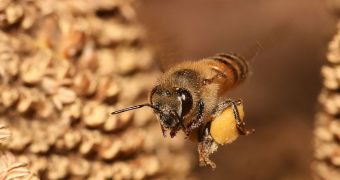Scientists have known for some time now that bees see the world about five times faster than humans do. However, details of this ability have been scarce, until recently. Researchers at the Queen Mary, University of London, in the United Kingdom, managed to infer that these insects have the fastest color vision in the animal world, given the speed at which they fly. Bumblebees are apparently best at it, being able to navigate all manner of obstacles with ease, PhysOrg reports.
In charge of the research team were experts Dr Peter Skorupski and professor Lars Chittka, who are both based at the university. Details of their investigation have been published in the latest issue of the respected Journal of Neuroscience. They highlight the fact that the ability to see extremely well is not something only bees are capable of. Generally, all fast-flying insects tend to be extremely good at making out obstacles, movement and changes in their field-of-view, which in some cases is considerably more extensive than that of humans.
Some of the evolutionary reasons for why this trait developed is the fact that they need to escape predators, which are oftentimes larger and better equipped than they are. Additionally, some species only mate in mid-air, and sight plays a crucial role in this. What researchers were really interested in knowing about bees was whether the full-color vision that the creatures evidenced was able to keep up with their amazing flight speed. The new investigation suggests that, though the bumblebees' vision is slower than the actual flight, it's still about twice as fast and efficient as that of humans.
“We can't easily follow a fast flying insect by eye, but they can follow each other, thanks to their very fast vision. How fast you can see depends on how quickly the light-detecting cells in your eye can capture snapshots of the world and send them to you brain. Most flying insects can see much quicker than humans, for example so they can avoid getting swatted!” says Skorupski, who conducted the new work while at the Queen Mary's School of Biological and Chemical Sciences Research Center for Psychology.
"Bees were the first animals that scientists proved to have color vision, and they have since been shown to put it to good use; navigating dappled light and shady areas, recognizing shapes like their hive entrance, and particularly for finding nectar-bearing colored flowers,” the scientist adds. “Bees' energy can't be used frivolously, as they need so much of it just to stay alive. It seems they only see colors at half the speed they see white light, which give them enough detail to find their favouite flowers and navigate back home,” Skorupski concludes.

 14 DAY TRIAL //
14 DAY TRIAL //